Balance 482 in the test: Long-distance vessel and performance catamaran
Johannes Erdmann
· 31.08.2023
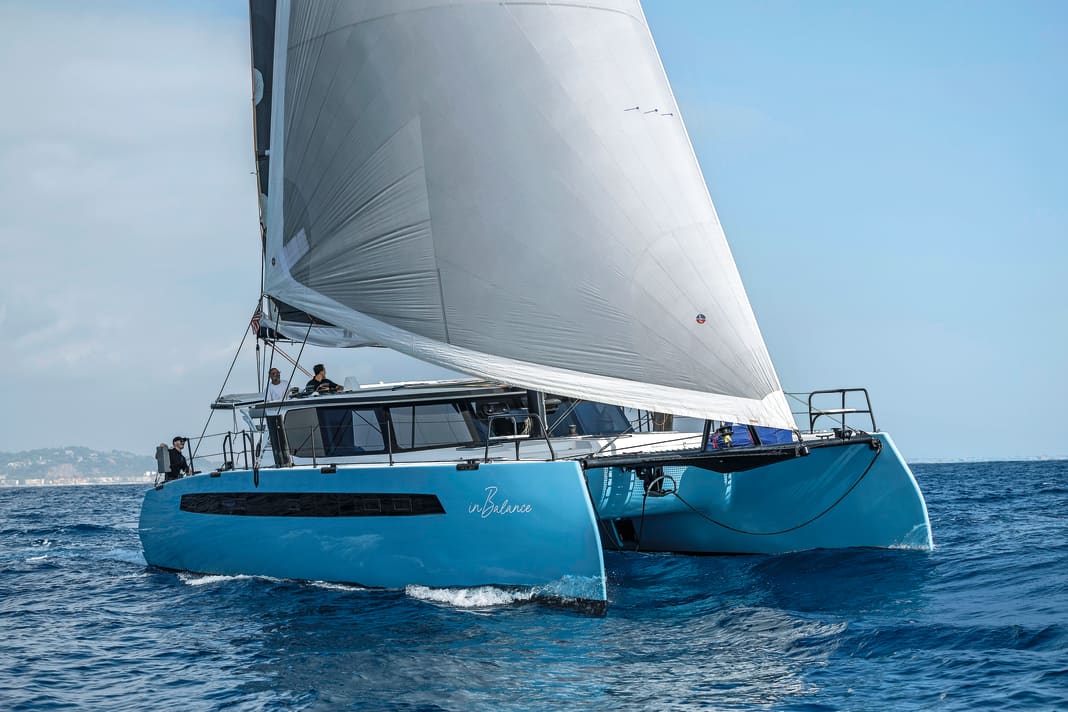





Most catamarans are built for the masses. Whether Lagoon, Fountaine Pajot, Excess or Nautitech - the shipyards' programmes always offer a similar range: a charter version with four cabins and an owner's version with a large owner's suite in one hull and two guest cabins in the other. The only difference between the two versions is the interior layout; the hulls are identical. The layout can often be customised with the equipment packages. Due to their design, all ships are suitable for travelling worldwide. However, there are certainly catamarans with which such a blue-water voyage goes a little better than with others.
Each catamaran is manufactured by hand using a vacuum process
One such vessel is the Balance 482 from South Africa: a performance cruising catamaran that is unrivalled in its niche on the market. The Balance series is consistently geared towards blue water cruising and owner operation. Boats that can be travelled anywhere comfortably and quickly in any weather. They offer the comfort of the upper class, but at the same time are as robust as a working boat. If you wanted to categorise the Balance, it would be a sport utility vehicle - a sailing SUV.
Balance Catamarans in South Africa was founded in 2013 by Phillip Berman, who already had an intimate connection to multihulls as a Hobie Cat 14 world champion in 1979 and who had repeatedly asked himself the question over many decades as a yacht broker: "Why are there no high-performance catamarans that offer comfortable living?" So he took it upon himself to fill this gap in the market. Today, the Balance range extends from 44 to 75 feet.
Each boat is manufactured by hand using a vacuum process. The shipyard uses E-glass and a closed-cell foam core as materials, with additional carbon in the areas subject to greater stress.
Balance relies on the helmstand concept of the 2000s
As soon as you step on deck, you get the impression that you are on a boat that is not only intended as a comfortable floating residence on the water - and that is certainly true - but also as a functional object. Instead of teak or a synthetic variant, the cockpit is covered with Seadek, which offers exceptionally good grip when wet, but has a rather foam-like and shock-absorbing consistency. More functional than elegant.
While many other catamarans today are built with either a flybridge or two helm stations at the outer end of the cockpit, Balance relies on the concept of the 2000s: the helm station on the 482 is positioned slightly elevated on the forward cockpit bulkhead. From there, every bow and stern can be seen during harbour manoeuvres. The 90-centimetre wheel sits comfortably in the hand and the steering is very direct thanks to the cable connection. As a special highlight, Balance has made the steering wheel foldable. The "Versahelm" has three positions: firstly, the steering position all the way out, and secondly, a centre "reefing position" in which the wheel is folded to port so that the winches can be worked on comfortably, but the wheel is still within reach. In bad weather, it can be folded down as a third position, into the entrance area of the saloon, from where the large saloon windows made of sturdy laminated glass provide an almost all-round view.
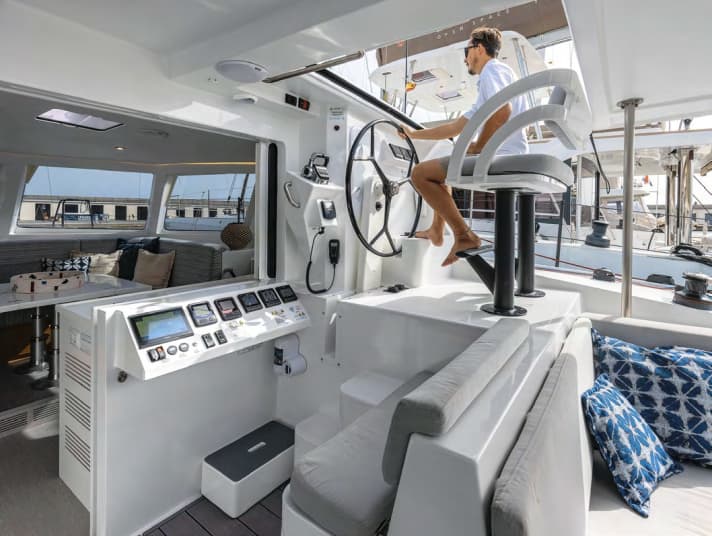
In practice, the swivelling steering column is somewhat rickety, but practical. The roof above it can be closed in bad weather. This allows the helmsman to steer the boat through the storm in his pyjamas at the helm, even in spray and rain. The large sliding door is made entirely of carbon fibre. Stainless steel was not used wherever it would be exposed to the sea and sunlight.
The saloon of the Balance 482 is practical and spacious
The cockpit is divided into three areas: On the port side there is an L-shaped seating area, on the starboard side the second helm position for rough weather or long trips with a 1.55 metre long bench seat, plus two additional sofas or lounging areas in the stern.
The saloon is very practically designed, with a galley to port and a kitchen island that not only has plenty of storage space, but also a 1.60 metre long and 0.40 metre wide work surface, making cooking a group event. To starboard there is a U-shaped sofa, which is shaped as a chaise longue on the left-hand side and offers a good surface to lie on during night-time or open-air watches. To the left is a wide chart table with a view forward and plenty of space for instruments.
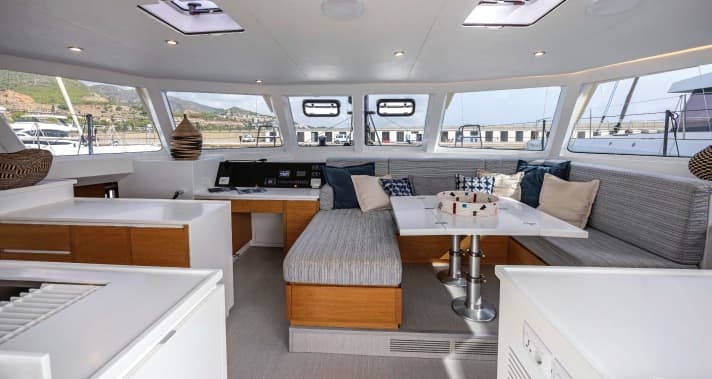
At the bulkhead to the cockpit there is a battery of four pull-out fridges and freezers, ideal for large provisions. Only the ventilation through large windows or deck hatches is a little sparse in the saloon. All built-in parts are made of lightweight foam panels, with fronts made of real wood. In this way, it has been possible to keep the boat relatively light at 13.3 tonnes.
Unconventional: the owner's cabin to starboard at the front and a bathroom the size of a tiny house at the rear
The owner's hull is located on the starboard side and the guest hull with two cabins on the port side. As the Balance is specially built for living on board, it differs enormously from normal production boats. The bathroom in the owner's hull, for example, is located in the stern, with a shower the size of a tiny house that is unrivalled anywhere in the world. The footwell measures 1.06 by 1.10 metres and is enclosed by an L-shaped bench seat (1.47 by 1.49 metres), which could easily seat four people. "The owner wanted it that way," says Joe Landman, skipper of the boat. By removing the rear wall of a shelf, the pulley steering mechanism, which is neatly installed and well dimensioned, can be reached from the bathroom. "There are maintenance hatches like this in many places," says Landman, "during development it was important to us that all elements were easily accessible and repairable."
The way forward into the owner's cabin leads through a narrow corridor framed on both sides by deep cupboards. While most of the cupboards are intended as generous storage space, the first one contains the watermaker (Schenker) at the bottom and a fuse box at the top, as you would expect to find in a large apartment block. "Because this boat is to sail around the world, both a 230-volt and a 110-volt power supply are installed on board," explains Landman. The on-board power supply is also 48 volts (lithium). The advantage of this is that with an Integrel alternator on each of the drive motors, there is no need to install a generator.
Can the Balance 482 live up to its sporty look under sail?
The owner's cabin is located at the front of the bow, below the mast and in the ship's centre of rotation. Other shipyards would accommodate a double bunk bed in the large attached bow section. At Balance, this space remains empty. After all, you can always use storage space. At the head of the bed there is a window to the line locker on deck. If the lid remains open at anchor, the wind can flow into the cabin without it raining in. Many of these details clearly show how remarkably well thought-out the boat is. The large deckhouse, for example, is shaped in such a way that rainwater collects and can be collected via an opening with a Gardena connection.
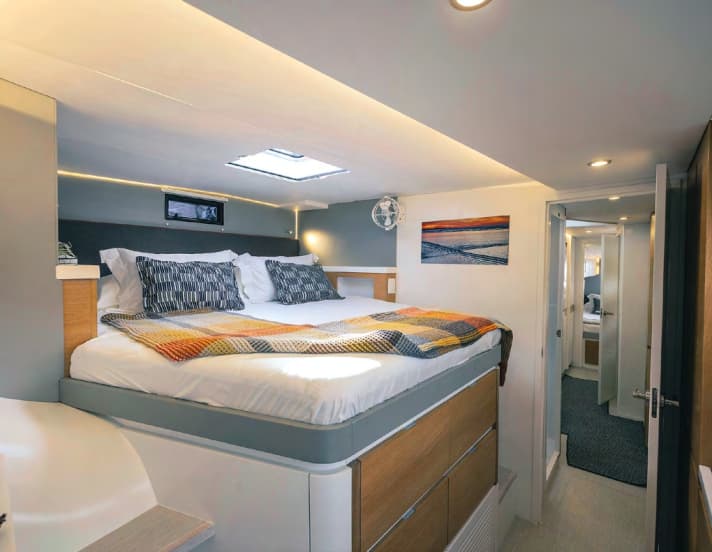
The test ship is equipped with two electrically retractable carbon centreboards, which reduce the draught from 2.20 to 1.16 metres at the touch of a button. At 2.3 metres wide, the hulls are extremely narrow and, in combination with the very high freeboard of 2.00 metres (bow), give the boat an extremely sporty look. But does the boat live up to its look under sail?
The harbour and sailing manoeuvres are also easy with a small crew or even single-handed thanks to the clearly laid out steering position. Only the motorisation of the Balance is a little weak with two 45 hp engines. The mainsail glides quickly up the mast thanks to the electric winch and, together with the self-tacking jib, creates a sail area of around 133 square metres. The boom is set very low for a lower sail pressure point and better handling when packing the sail.
In the light winds blowing off Port Ginesta in Spain during the test, the Balance reaches an angle of 50 degrees to the wind and runs between seven and nine knots, which are acceptable values. The old swell makes cruising difficult. In the waves it is noticeable that the cat pitches a little, which may be due to the flat underwater hull, which finds gliding down the waves more comfortable than sailing against them. After a couple of cross-overs, we set the Code Zero-like screecher and reach speeds of up to ten knots. The Balance needs a little wind to be in its element. A typical Cape boat from South Africa.
The measured values for the Balance 482 test
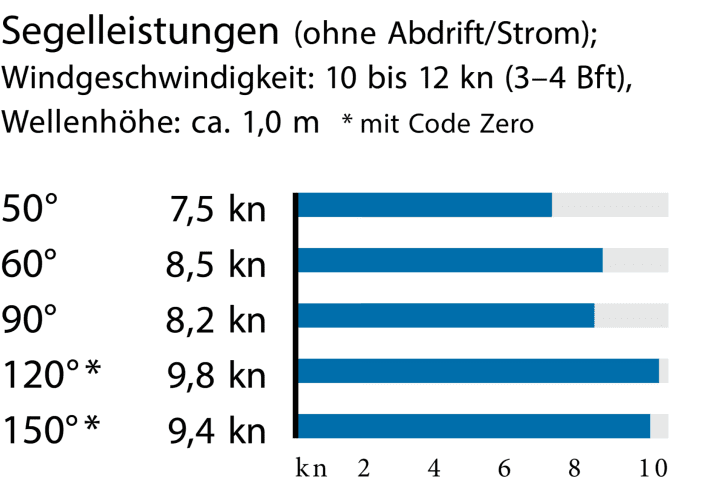


The Balance 482 in detail
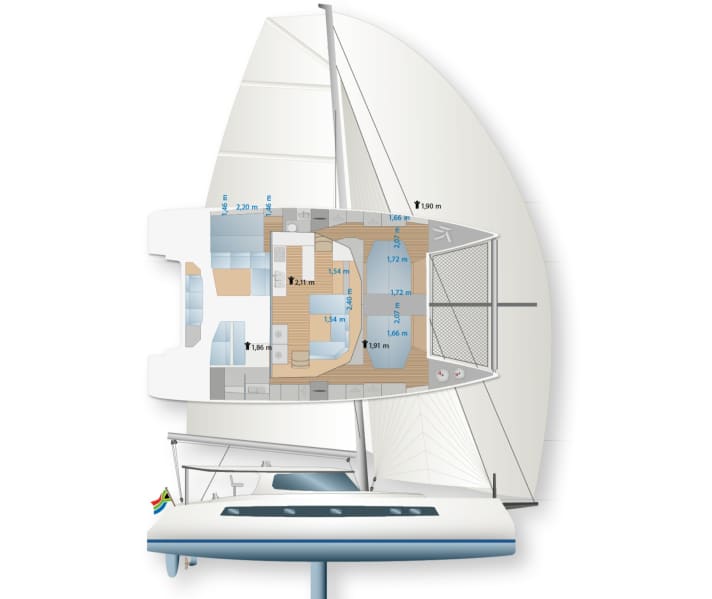
Technical data Balance 482
- Design engineer: Berman/Du Toit
- CE design category: A
- Total length: 14,71 m
- Waterline length: 14,71 m
- Width: 7,90 m
- Draft (swords): 2,30/1,16 m
- Mast height above WL: 22,20 m
- Theor. torso speed: 9.3 kn
- Weight: 11,5 t
- Mainsail: 89,6 m²
- Self-tacking jib (82 %): 43,5 m²
- Code Zero: 72,9 m²
- Gennaker:183,1 m²
- Engine (Yanmar): 2x 33 kW/45 hp
- Fuel tank: 2x 400 litres
- Fresh water tank: 2x 390 litres
- Holding tank: 2x 61 litres
Hull and deck construction
Manufactured in a vacuum process from GRP (E-glass) with a closed-cell foam core; carbon fibre is also used in areas subject to greater stress. Polyester on the inside, vinylester on the outside. A keel version is also available
Sail
The sails are included, but a square top mainsail and foresail made of laminate cost an extra 21,290 euros
Motors
Two 45 hp Yanmar engines with Saildrive, an upgrade is not planned. With Integrel generators and lithium bank for an extra charge
Electronics
The basic package includes all instruments (Raymarine), 9-inch plotter, VHF and autopilot. Further instruments can be selected as extras ex shipyard
Living space
Three cabins and plenty of storage space. While the owner has a stately bathroom, the guests have to share a small wet room
Equipment and prices
- Base price ex shipyard: 1.453.304 €
- Price ready to sail : 1.462.229 €
- Comfort price : 1.532.007 €
- Guarantee/against osmosis: 1/3 years
Prices as of 08/2023, as the prices shown are defined, you will find here !
Shipyard and distribution
Balance-Catamarans
YACHT rating Balance 482
The Balance 482 is a ship for travelling the world. Stable and lightly built, generously equipped. Ideal for ocean crossings. However, at 1.5 million euros, it is not cheap in a long-distance version
Design and concept
- + Well thought-out concept
- + Sturdy construction
- + Heavy-duty equipment
Sailing performance and trim
- + Can be sailed single-handed
- + Optimised for space wind
- - Needs some wind
Living and finishing quality
- + Processing quality
- + Panoramic view in the lounge
- - Senselessly large shower
Equipment and technology
- + Good energy concept
- + Excellent installations
This might also interest you:
- Bali Catspace 40: Two hulls for connoisseurs
- The most important catamaran innovations of the year
- CAT 72: 22 metre catamaran with automatic foils

